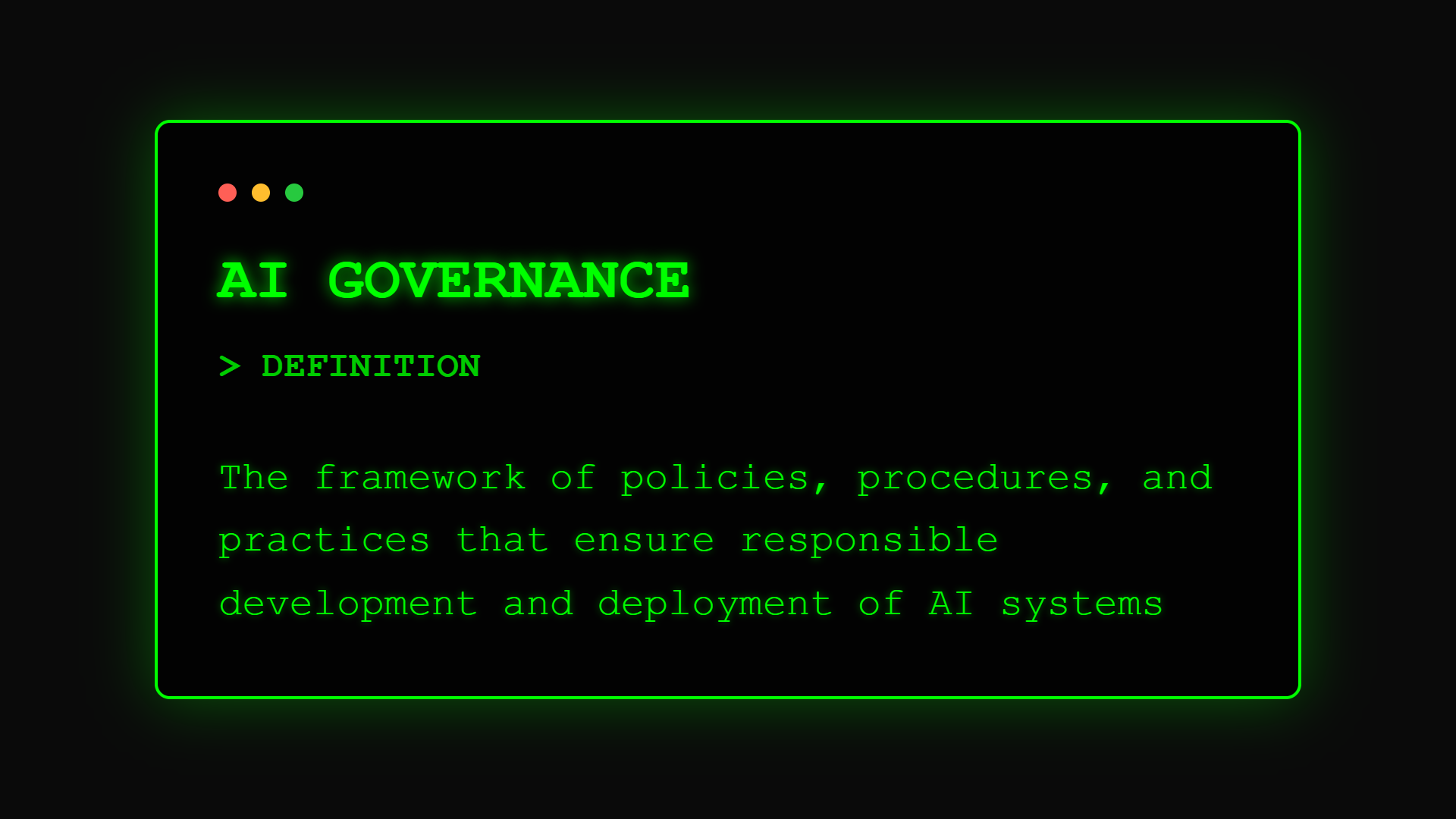AI Terms
What is AI Governance? The Board's Guide to AI Control

Your company now makes millions of AI-powered decisions daily. Who's accountable when things go wrong? How do you ensure compliance across dozens of AI systems? AI governance provides the framework to manage AI responsibly while maximizing its value.
Defining AI Governance
AI governance encompasses the policies, processes, and practices that ensure artificial intelligence systems are developed and deployed in alignment with organizational values, regulatory requirements, and stakeholder expectations. It establishes accountability, oversight, and control mechanisms for AI throughout its lifecycle.
According to the World Economic Forum, "AI governance is the guardrails that ensure AI systems are human-centered, inclusive, and beneficial to society while managing associated risks." It emerged as organizations realized that ungoverned AI creates legal, financial, and reputational risks.
Unlike traditional IT governance, AI governance must address unique challenges like algorithmic bias, explainability requirements, and continuous learning systems that evolve post-deployment.
Executive Perspective
For business leaders, AI governance is your insurance policy and growth enabler – it prevents costly failures while creating the confidence needed for ambitious AI initiatives that drive competitive advantage.
Think of AI governance like financial controls. Just as you wouldn't let employees spend company money without oversight, you shouldn't let AI make decisions without governance. It's about enabling innovation responsibly.
In practical terms, AI governance means clear policies on AI use, defined approval processes for new AI projects, ongoing monitoring of AI decisions, and accountability structures that satisfy boards, regulators, and stakeholders.
Core Components
AI governance frameworks include:
• Policy Framework: Clear guidelines on acceptable AI use, ethical principles, risk tolerance, and decision rights across the organization
• Organizational Structure: Defined roles including AI ethics boards, risk committees, and clear accountability from development through deployment
• Risk Management: Systematic identification, assessment, and mitigation of AI-specific risks including bias, security, and operational failures
• Compliance Processes: Procedures ensuring adherence to regulations (GDPR, AI Act), industry standards, and internal policies
• Performance Monitoring: Continuous tracking of AI system behavior, business impact, and risk indicators with defined escalation paths
Governance Lifecycle
AI governance operates across phases:
Strategy & Planning: Define AI vision, principles, and risk appetite aligned with business strategy and stakeholder values
Development Governance: Review processes for AI projects including ethics assessments, bias testing, and approval gates
Deployment Controls: Standards for production deployment including testing requirements, rollback procedures, and monitoring setup
Operational Oversight: Ongoing monitoring of AI performance, risk metrics, and compliance with regular reviews and updates
Continuous Improvement: Regular assessment of governance effectiveness with updates based on incidents, regulations, and learnings
Governance Maturity Model
Organizations progress through levels:
Level 1: Ad Hoc Characteristics: Project-specific decisions, no standards Risks: Inconsistent practices, compliance gaps Example: Each team decides own AI approach
Level 2: Defined Characteristics: Written policies, designated owners Risks: Limited enforcement, siloed approach Example: AI policy exists but voluntary adoption
Level 3: Managed Characteristics: Enforced processes, regular reviews Risks: Reactive rather than proactive Example: AI review board approves all projects
Level 4: Optimized Characteristics: Proactive governance, continuous improvement Risks: Minimal and well-managed Example: AI governance integrated into enterprise risk
Real-World Governance
Organizations leading in AI governance:
Financial Services Example: JPMorgan Chase's AI governance framework includes a firmwide AI ethics committee, mandatory bias testing for all models, and quarterly board reporting on AI risks, enabling deployment of 300+ AI use cases while maintaining trust.
Healthcare Example: Cleveland Clinic's AI governance requires clinical validation for all AI tools, patient consent processes, and continuous monitoring of outcomes, resulting in safe deployment of diagnostic AI while maintaining patient trust.
Technology Example: Google's AI Principles and governance structure includes ethics review for sensitive applications, resulting in decisions to not pursue certain lucrative contracts that violated their principles, strengthening long-term brand value.
Key Governance Areas
Critical domains requiring governance:
Data Governance:
- Data quality standards
- Privacy protection
- Consent management
- Data lineage tracking
Model Governance:
- Development standards
- Testing requirements
- Version control
- Performance thresholds
Operational Governance:
- Deployment approvals
- Monitoring requirements
- Incident response
- Change management
Vendor Governance:
- Third-party AI assessment
- Contractual requirements
- Ongoing oversight
- Risk allocation
Common Governance Gaps
Typical weaknesses and solutions:
• Unclear Accountability: No one owns AI outcomes → Solution: RACI matrix for AI lifecycle with executive sponsorship
• Policy-Practice Gap: Good policies, poor execution → Solution: Automated governance tools and regular audits
• Siloed Governance: IT, legal, business separate → Solution: Cross-functional governance committees
• Static Approach: Governance doesn't evolve → Solution: Quarterly reviews and continuous updates
Building Your Governance
Steps to effective AI governance:
- Start with AI Ethics principles as foundation
- Implement Explainable AI for transparency
- Address Bias in AI through governance controls
- Read our AI Governance Playbook
Part of the [AI Terms Collection]. Last updated: 2025-01-11